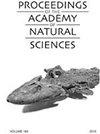白内障慈鲷科(慈鲷目:慈鲷科),圭亚那和委内瑞拉Essequibo盆地孔雀鲈鱼的新种
IF 0.5
4区 环境科学与生态学
Q4 BIODIVERSITY CONSERVATION
Proceedings of the Academy of Natural Sciences of Philadelphia
Pub Date : 2020-03-17
DOI:10.1635/053.167.0106
引用次数: 11
摘要
摘要通过分子证据和独特的成鱼和幼鱼色素沉着模式,将孔雀鲈鱼(Cichla cataractae)与所有同系种区分开来。幼鱼(< 150mm SL)身体两侧有三个明显的黑色斑点,其中软背鳍下方的斑点最大,后部减弱(长泪滴状),但明显与椭圆形尾端斑点分开;在最大的幼鱼中相同的斑点最终具苍白的边缘(细胞化)。两侧的成虫模式由两个明显的深色斑点占主导地位,每一个细胞;圆形的前斑点,位于棘状背鳍的前基部以下和不延伸于前侧线以上;在形状上高度不规则的后斑点,位于软背鳍下面并且经常背向移位;在棘状背鳍的后基部下面的另外的深色斑点通常无或小,细胞状与否,和与前斑点水平;在侧面的竖杆通常没有或微弱;眶后条纹总是存在,高度破碎成不规则系列的黑点,每一个通常是细胞状的。卡塔卡奇拉是埃塞奎博盆地特有的,它通常栖息在水流湍急的河道中的岩石浅滩上。这个新物种与分布更广泛的C. ocellaris是同域的,C. ocellaris是一种更喜欢在野外栖息的物种。分子分析支持C. cataractae作为一种独特的谱系,存在于包含C. temensis、C. melaniae、C. mirianae、C. piquiti和C. pinima的蛭科中。现存最古老的新物种标本由Carl H. Eigenmann于1908年收集,并记录在他的开创性著作《英属圭亚那淡水鱼》(Eigenmann, 1912)中。本文章由计算机程序翻译,如有差异,请以英文原文为准。
Cichla cataractae (Cichliformes: Cichlidae), new species of peacock bass from the Essequibo Basin, Guyana and Venezuela
ABSTRACT. A new species of peacock bass, Cichla cataractae, is distinguished from all congeners by molecular evidence and unique patterns of adult and juvenile pigmentation. Juveniles (<150 mm SL) have sides of body dominated by a series of three conspicuous dark blotches with the one below soft dorsal fin largest, attenuated posteriorly (long teardrop shape) but distinctly separated from elliptical caudal blotch; same blotches eventually with pale border (ocellated) in largest juveniles. Adult pattern on sides dominated by two distinct dark blotches, each one ocellated; anterior blotch rounded, located below anterior base of spinous dorsal fin and not extending above anterior lateral line; posterior blotch highly irregular in shape, located below soft dorsal fin and often displaced dorsally; additional dark blotch below posterior base of spinous dorsal fin generally absent or small, ocellated or not, and level with anterior blotch; vertical bars on sides generally absent or faint; postorbital stripe always present, highly broken into irregular series of dark spots, each one usually ocellated. Cichla cataractae is endemic to the Essequibo Basin where it typically inhabits rocky shoals in river channels with swift current. The new species is sympatric with the more widely distributed C. ocellaris, a species that prefers lentic habitats. Molecular analysis supports C. cataractae as a distinct lineage in a clade of Cichla containing C. temensis, C. melaniae, C. mirianae, C. piquiti and C. pinima. The oldest extant specimens of the new species were collected by Carl H. Eigenmann in 1908 and documented in his seminal "The Freshwater Fishes of British Guiana" (Eigenmann, 1912).
求助全文
通过发布文献求助,成功后即可免费获取论文全文。
去求助
来源期刊

Proceedings of the Academy of Natural Sciences of Philadelphia
生物多样性保护-生物多样性保护
自引率
0.00%
发文量
4
期刊介绍:
The Proceedings (ISSN 0097-3157) has been published continuously since 1841. Many volumes are still available in their original printings. Early volumes are unbound, constituting two or three issues per year. Quantities of some volumes may be limited. Early volumes may have slightly soiled cover sheets, but the text blocks are perfect.
 求助内容:
求助内容: 应助结果提醒方式:
应助结果提醒方式:


